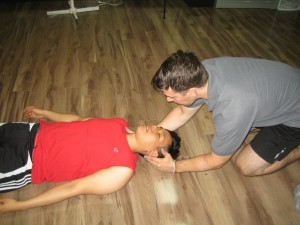Spinal injury, also known as spinal cord injury or SCI, is a very serious condition, because it can result to paralysis and/or permanent disability on the injury site. The most common affected sites of the injury include the back of the neck, the spinal region down, and the lower back. Fortunately, you can lessen the risk of causing further damage to the spinal cord by having proper education on how to treat patients during emergency spinal injury incidents.
What are the common causes of spinal injury?
- Stab or bullet wound
- Trauma to the head region, chest and back (for instance, concussion resulting from severe car accident, or diving accidents)
- Extreme, sudden twisting of the middle body
- Accidental landing on head during sports activities
- Falling off a tall height
How to suspect if a patient has spinal injury?
- The person experience sudden change in the level of consciousness
- Complaints of severe pain on the back, head or neck
- Inability to move head or neck because of severe pain
- Complaints of numbness and numbness on the injured part
- Inability to move or control limbs after severe back injury
What to do in case of spinal injury emergency?
- First things first, do not move a patient whom you suspect has a spinal injury unless it is extremely necessary (for instance, removing the patient from the site of accident to prevent falling debris from further causing injuries)

- Call the emergency hotline as soon as possible while performing first aid
- Stabilize the head and neck; keep them still until professional help arrives
- It is necessary to keep the head and neck in the same position as you found the victim. Do not twist, attempt to straighten or create any movements, because these can cause further injuries
- Only move the head if you are going to perform rescue breathing
- Begin CPR, but do not move the head of the patient. If you need to do rescue breathing, do not move the chin up; instead, pull the jaw downwards to create airway opening.
- Stay with the injured victim until professional help arrive
- Important – if you are going to move or roll the person from one place to another, look for someone who can assist you, so you only create the minimum head/neck movement possible
These simple yet helpful first aid tips for assisting patients who have spinal injury is necessary to save someone’s life. If you want to know more about first aid techniques, look for professional emergency training near your area.
Sources:
“How to treat a spinal injury victim.” Wikihow. Retrieved online on June 7, 2013 from http://www.wikihow.com/Treat-a-Spinal-Injury-Victim
“Spinal Injury: First Aid.” Mayoclinic. Retrieved online on June 7, 2013 from Spinal Injury: First Aid
